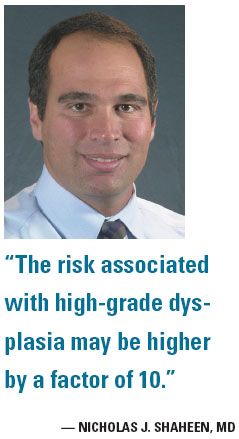Early study shows promise for radiofrequency ablation in dysplastic Barrett esophagus
Radiofrequency ablation can decrease disease progression in patients with dysplastic Barrett esophagus, or metaplasia of the espophageal epithelium, according to a study out of the University of North Carolina in Chapel Hill. The researchers also found that the technique eradicated dysplasia and intestinal metaplasia.
Radiofrequency ablation can decrease disease progression in patients with dysplastic Barrett esophagus, or metaplasia of the espophageal epithelium, according to a study out of the University of North Carolina in Chapel Hill. The researchers also found that the technique eradicated dysplasia and intestinal metaplasia.

Approximately 10% of patients with chronic reflux have Barrett esophagus, and a recent population study concluded that 1.6% of the general population have the condition. While the number of people suffering from the disease is fairly large, an optimal management strategy for dysplastic Barrett esophagus has not been defined.
Nicholas J. Shaheen, MD, professor of medicine and epidemiology, and colleagues sought to determine the effects of radiofrequency ablation (RFA) on the disease as a less invasive form of treatment. The researchers found that for 64 patients with low-grade dysplasia, complete eradication of dysplasia occurred in 90.5% of the RFA group compared with 22.7% of the control group (N Engl J Med 360:2277-2288, 2009).
Dr. Shaheen and his team recruited patients from 19 sites in the U.S. with endoscopically evident, non-nodular, dysplastic Barrett esophagus of no more than 8 cm in length. From 755 screened patients, 127 were randomly assigned to receive either RFA (ablation group) or a sham procedure (control group). Primary outcomes at 12 months included the complete eradication of dysplasia and intestinal metaplasia.
Among the 63 patients with high-grade dysplasia, complete eradication occurred in 81% of the RFA group compared with 19% of the control. Overall, 77.4% of patients in the RFA group had complete eradication of intestinal metaplasia compared with 2.3% in the control group. In addition, the patients in the RFA group had less disease progression and fewer cancers.
However, the authors noted that the decreased incidence of cancer should be viewed with caution considering cancers occurred in only five patients: The shift of a single incident of cancer from the control group to the ablation group would have resulted in a loss of statistical significance.
The strengths of the study include rigorous masking of study group assignments, expert histologic analysis of biopsy samples, and a low, nondifferential loss to follow up, Dr. Shaheen wrote.
Limitations of the study include using eradication of intestinal metaplasia and dysplasia, along with neoplastic progression, as surrogate markers for death from cancer.
“Although other data suggest that reversion to neosquamous epithelium after radiofrequency ablation is durable, it is not clear whether the results of the study will persist,” Dr. Shaheen said. Issues that still need to be worked out are whether radiofrequency ablation is superior to other interventions (esophagectomy) and if the results of this study are reproducible.
The current study examines both low-grade and high-grade dysplasia, but the implications for the two diagnoses are different.
“Low-grade dysplasia implies a risk of progression to cancer of less than 1% per patient year, whereas the risk associated with high-grade dysplasia may be higher by a factor of 10,” Dr. Shaheen said.
The distinction is important because in making decisions about the management of precancerous conditions, greater risks and costs are tolerable for high-grade dysplasia. For less severe disease, the safety profile and associated costs become increasingly important. Dr. Shaheen noted this study cannot answer those questions.
“Regardless, both of the dysplasia subgroups showed high rates of reversion to squamous epithelium after RFA and reduced rates of disease progression with few serious adverse effects, suggesting that the application of ablative therapy in patients with low-grade dysplasia is worth further investigation and consideration,” he said.
VANTAGE POINT
Must determine which patients would benefit most from RFA
Jacques J. G. H. M. Bergman, MD, PHD
Dr. Shaheen’s study has important implications for the treatment of high-grade dysplasia in patients with Barrett esophagus, wrote Dr. Bergman, a professor of gastroenterology at the Academic Medical Center in Amsterdam (N Engl J Med 360:2353-2355, 2009).

“The results are far better than those of other ablative therapies that have been evaluated for this indication,” he said. The findings also suggest that surgery for high-grade dysplasia should no longer be offered routinely-a treatment with a 3% to 5% death rate, a complication rate of 40% to 50%, and a permanent loss of the functional esophagus, Dr. Bergman said.
“One of the challenges we face is to develop training programs aimed at the entire spectrum of endoscopic management of Barrett esophagus so that currently reported efficacy and safety profiles are maintained,” he said.
Dr. Bergman also questioned whether RFA is justified for the large group of patients with nondysplastic Barrett esophagus and decided that it was too early to tell. He did suggest that a randomized comparison of endoscopic surveillance and RFA for nondysplastic Barrett esophagus was necessary.
“Such a study might truly revolutionize the management of this condition and answer the question as to whether RFA is great just for some or justified for many,” he said.